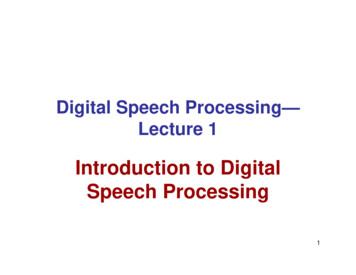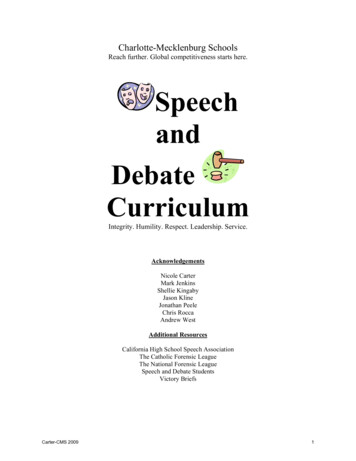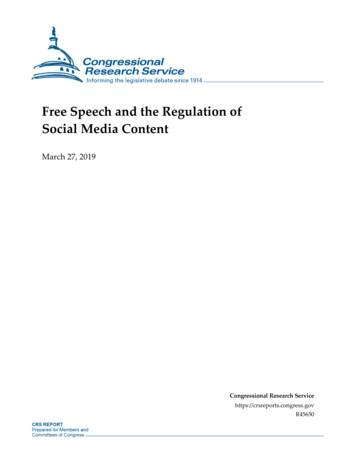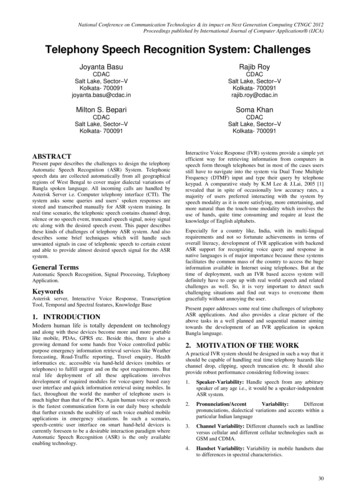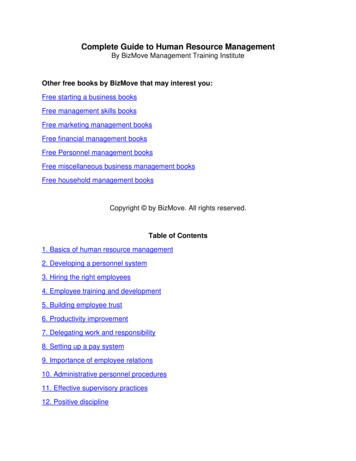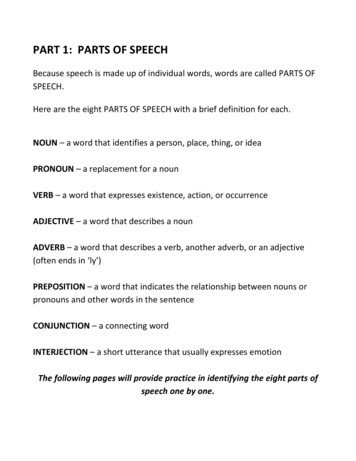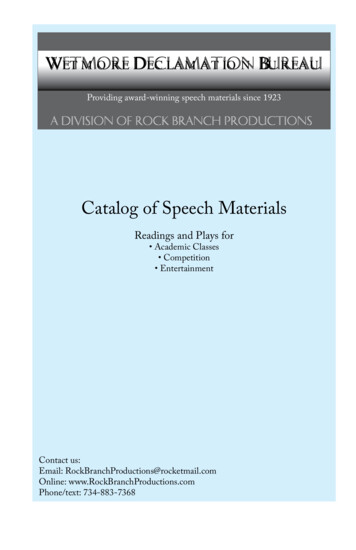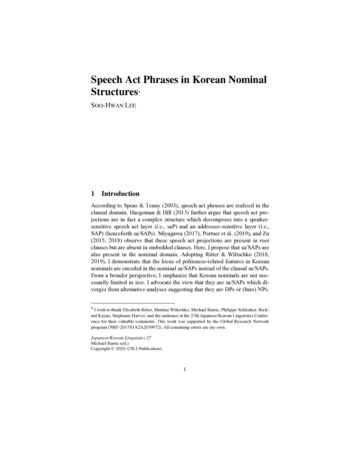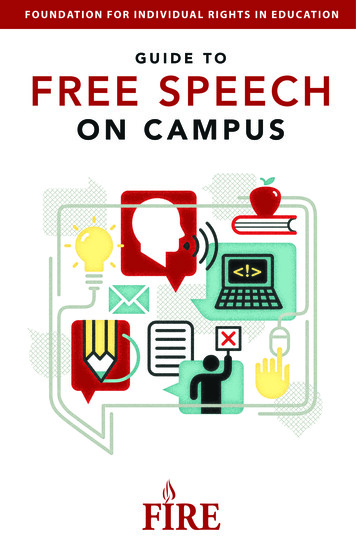
Transcription
GUIDE TOFREE SPEECHON CAMPUS
’s GUIDE TOFREE SPEECH ON CAMPUS
’s GUIDES TOSTUDENT RIGHTS ON CAMPUSFIRE’s Guide to Religious Liberty on CampusFIRE’s Guide to Student Fees, Funding, and Legal Equalityon CampusFIRE’s Guide to Due Process and Fair Procedure on CampusFIRE’s Guide to Free Speech on CampusFIRE’s Guide to First-Year Orientation andThought Reform on CampusGreg LukianoffPresidentAlan Charles KorsCo-founder and Chairman EmeritusBOARD OF DIRECTORSHarvey A. SilverglateCo-founder and ChairmanBarbara BishopMarlene MieskeRebecca Walter DunnDaphne PataiRichard LosickVirginia PostrelJoseph M. MalineDaniel ShuchmanKenny J. Williams (d. 2003)BOARD OF EDITORSVivian BergerT. Kenneth Cribb, Jr.Alan DershowitzPaul McMastersEdwin Meese IIIRoger PilonJamin RaskinNadine Strossen
’s GUIDE TOFREE SPEECHON CAMPUSAUTHORS:Harvey A. SilverglateDavid FrenchGreg LukianoffEDITORS, SECOND EDITION:Greg LukianoffWilliam CreeleyFoundation for Individual Rights in EducationPhiladelphia
First edition copyright 2005 by the Foundation for Individual Rights inEducation.Second edition copyright 2012 by the Foundation for Individual Rights inEducation.All rights reserved. No part of this publication may be reproduced or transmitted in any form or by any means, electronic or mechanical, includingphotocopy, or any information storage and retrieval system now known or tobe invented, without permission in writing from the publisher, except by areviewer who wishes to quote brief passages in connection with a review written for inclusion in a magazine, newspaper, or broadcast.FIRE invites and welcomes requests for reproduction and retransmission ofthis publication. Contact: guides@thefire.org.Library of Congress Control Number: 2012935981ISBN 978-0-615-56296-4Published in the United States of America by:Foundation for Individual Rights in Education601 Walnut Street, Suite 510Philadelphia, Pennsylvania 19106Cover design by Sarafina Creeley.Printed in the United States of America.
ACKNOWLEDGMENTSFIRE’s Guides to Student Rights on Campus are madepossible by contributions from thousands of individualdonors and by the support of a number of foundations,including:The Achelis and Bodman FoundationsAequus InstituteAnonymousThe Atlas Economic Research FoundationEarhart FoundationPierre F. and Enid Goodrich FoundationThe Joseph Harrison Jackson FoundationJohn Templeton FoundationFIRE gratefully acknowledges their generous support.If you would like to support FIRE’s efforts to promotefree speech on campus—efforts that include the distribution of this Guide to students across the country—pleasevisit thefire.org/support.VII
CONTENTSNote on The Second EditionxiiiPreface: “The Mansion House of Liberty”1Introduction: Free Speech Then and NowA Philosophy of Free Speech: John Stuart MillFree Speech: A Brief HistoryThe Alien and Sedition Acts36910The Slavery Debate and Attempts to Silence Abolitionists11After the Civil War: Censorship by Mob and byPrudishness 13The Birth of Modern Free Speech Doctrine During the “RedScares” 14The Expansion of Speech Protections from the 1950s to the1970s 17The 1980s and 1990s: Flag Burning, Speech Codes,“Harassment,” and College Campuses 19The 2000s: Despite Continued Defeats in Court, CampusCensorship Persists 22Today: “Bullying” and Online SpeechIX25
’s Guide to Free Speech on CampusFree Speech: The BasicsWhat Is Speech?2828Categories of Unprotected Speech“Fighting Words”3233The Fighting Words Doctrine: A Source of ConfusionFighting Words on CampusObscenity373842Indecent Speech44Special Rules for the Educational Setting: Less or MoreFreedom on Campus? 50High School versus College: A Clear DistinctionFree Speech and the Private University5057Individual State Laws Affecting Private Institutions60Protecting Your Freedom at the Private University: PracticalSteps 66Summary of Free Speech Rights on Private CampusesKnow Your Censors and Your Rights6970Compelled Speech and the Constitutional Ban onEstablishing a Political Orthodoxy 71Political Orthodoxies on Campus74The Constitution Does Not Allow Overbreadth76How and Why the Constitution Does Not PermitVagueness 78How and Why the Constitution Does Not Allow ViewpointDiscrimination 83How and Why the Constitution Does Not Allow PriorRestraint 85X
ContentsThe Student Press and Prior RestraintHarassment Codes on Campus8890Defining Harassment on Campus91The Misuse of Harassment Codes96Challenging Your University’s Speech CodeQuid Pro Quo Harassment102106Common Legal Limits on Speech111When, Where, and How? Time, Place, and MannerRestrictions 112What Kind of Discrimination—Content or Viewpoint?118When Is a Time, Place, and Manner RegulationUnconstitutional? 119Faculty Speech122Academic Freedom127Defamation (Libel and Slander)135Constitutional Limits on Defamation ClaimsCategories of People140141Categories of Statements143Online Speech: The First Amendment in theInternet Age 145From Law Books and Theories to Practice: FreeSpeech on Today’s Campuses 1511. Your College Enacts (or Considers Enacting) a Policy ThatBans “Offensive” or “Harassing” Speech 152What If Your University Is Considering a Speech Code?154What If Your University Already Has a Speech Code (As ItProbably Does)? 157XI
’s Guide to Free Speech on Campus2. Abuse of Hostile Environment Law: Tufts University andThe Primary Source 1623. Libel: University of North Carolina Wilmington 1644. Compelled Speech: Forcing Students to Utter Beliefs 1655. Free Speech Zones: West Virginia University 1686. Charging a Fee for Free Speech, Directly or Indirectly 1717. Newspaper Theft 1748. Investigating Protected Speech: University of AlaskaFairbanks 1769. Rough Times for Satire and Parody: Harvard BusinessSchool 17710. Allegedly Threatening or Intimidating Speech: San DiegoState University 18011. Restrictions on Religious Speech or Association:University of North Carolina 18212. Double Standards: University of California, San Diego 18713. Controversial Websites on University Servers 18914. Obscenity: University of Memphis 19115. Heckler’s Veto: Washington State University 19416. Controversial Speakers: Ithaca College 19617. Unequal Access for Student Groups—Denying the Rightto Freedom of Association: University of Miami 19718. Political Activity on Campus: University of Oklahoma 20019. Swearing: Hinds Community College 20220. Bullying and “Cyberbullying”: When Can a UniversityPunish a Student? 20421. “Spam” Policies: Michigan State University 20922. Fraternities, Sororities, and Freedom of Expression 21223. Punishment for Online Speech: Valdosta StateUniversity 217ConclusionCase Appendix221227XII
NOTE ON THESECOND EDITIONSince its first publication in 2005, the Foundation forIndividual Rights in Education (FIRE) has distributedmore than 138,000 print and online copies of its Guideto Free Speech on Campus. In that time, FIRE’s commitment to advocating on behalf of the essential rights discussed in the pages that follow has remained unwavering;however, threats to free speech on campus have evolvedsufficiently over the past six years to necessitate a new,revised edition of this Guide. Campuses have changed,too—in many cases, for the better, as students educatedby this book have worked with FIRE to fight for studentrights by reforming unconstitutional and illiberal speechcodes and ending myriad abuses of student liberties. Inaddition to our more than 200 public victories and manymore private ones, FIRE has impacted the legal landscapeas well; several of the new cases cited in this Guide are theresult of FIRE’s coordinated challenges to illiberal andXIII
’s Guide to Free Speech on Campusillegal restrictions on student speech. However, despiteFIRE’s sustained success, more work remains to be done.Too many campuses still silence students who dare exercise their right to free expression. It is our sincere hope,therefore, that this second edition of our Guide to FreeSpeech reaches every student who needs it—and it is ourforemost goal to see that it does.XIV
PREFACE: “THE MANSIONHOUSE OF LIBERTY”In 1644, John Milton, the great English poet, writingagainst censorship, called upon his nation to be “themansion house of liberty.” If the censors moved againstbooks, he warned, why would they not next move to banor license popular songs, preaching, conversations, oreven street entertainment? He urged authority to wantnot the outward conformity of coerced belief but, rather,the living choices of free and tested citizens. A person’scharacter, he wrote, is not worth praise if it “never salliesout and sees her adversary but slinks out of the race.” Themark of our character lay not in our protection from thewords of others, but in our responsibility for our ownchoices. He urged authority further to trust that, underliberty and law, truth (and virtue) would win in a freeand open contest against error and vice. “Let [truth] andfalsehood grapple, who ever knew truth put to the worse,in a free and open encounter.” Milton’s words—meant for1
’s Guide to Free Speech on Campusthe particular context of seventeenth-century England—rise above their historical setting. If any institution onearth should be “the mansion house of liberty,” trustingin “a free and open encounter” of truth and error, itshould be higher education in a free society. This Guideintends to move us closer to that ideal. Free speech is anindispensable part of human dignity, progress, and liberty.2
INTRODUCTION: FREESPEECH THEN AND NOWIf our legal reality truly reflected our political rhetoricabout liberty, Americans—and especially American college and university students—would be enjoying a trulyremarkable freedom to speak and express controversialideas at the dawn of the twenty-first century. Virtuallyevery public official declares a belief in “freedom ofspeech.” Politicians extol the virtues of freedom andboast of America’s unique status as a nation of unfetteredexpression. Judges pay homage to free speech in courtopinions. Even some fringe parties—communists andfascists who would create a totalitarian state if they werein power—have praised the virtues of the freedom theyneed for their survival.Few individuals speak more emphatically on behalf offreedom of speech and expression, however, than university administrators, and few institutions more clearlyadvertise their loyalty to this freedom than universities3
’s Guide to Free Speech on Campusthemselves. During the college application process, thereis a very high probability that you received pamphlets,brochures, booklets, and catalogs that loudly proclaimedthe university’s commitment to “free inquiry,” “academicfreedom,” “diversity,” “dialogue,” and “tolerance.”You may have believed these declarations, trusting thatboth public and private colleges and universities welcomeall views, no matter how far outside the mainstream, because they want honest difference and debate. Perhapsyour own ideas were “unusual” or “creative.” You couldbe a liberal student in a conservative community, a religious student at a secular institution, or even an anarchistsuffering under institutional regulations. Regardless ofyour background, you most likely saw college as the oneplace where you could go and hear almost anything—theone place where speech truly was free, where ideas weretried and tested under the keen and critical eyes of peersand scholars, where reason and values, not coercion, decided debate.Freedom and moral responsibility for the exercise ofone’s freedom are ways of being human, not means adopted to achieve this or that particular point of view.Unfortunately, ironically, and sadly, America’s collegesand universities are all too often dedicated more to censorship and indoctrination than to freedom and individual self-government. In order to protect “diversity” andto ensure “tolerance,” university officials proclaim, viewsdeemed hostile or offensive to some students and some4
Introduction: Free Speech Then and Nowpersuasions (and, indeed, some administrators) are properly subjected to censorship under campus codes.In the pages that follow, you will read of collegesthat enact “speech codes” that punish students for voicing opinions that simply offend other students, that attempt to force religious organizations to accept leaderswho are hostile to the message of the group, that restrictfree speech to minuscule “zones” on enormous campuses,and that teach students—sometimes from their very firstday on campus—that dissent, argument, parody, andeven critical thinking can be risky business. Simply put,at most of America’s colleges and universities, speech isfar from free. College officials, in betraying the standardsthat they endorse publicly and that their institutionshad, to the benefit of liberty, embraced historically, havefailed to be trustees and keepers of something precious inAmerican life.This Guide is an answer—and, we hope, an antidote—to the censorship and coercive indoctrination besettingour campuses. In these pages, you will obtain the toolsyou need to combat campus censors, and you will discover the true extent of your considerable free speechrights, rights that are useful only if you insist upon them.You will learn that others have faced (and overcome) thecensorship you confront, and you will discover that youhave allies in the fight to have your voice heard.The Guide is divided into four primary sections.This introduction provides a brief historical context for5
’s Guide to Free Speech on Campusunderstanding the present climate of censorship. The second section provides a basic introduction to free speechdoctrines. The third provides a series of real-world scenarios that demonstrate how the doctrines discussed inthis Guide have been applied on college campuses. Finally,a brief conclusion provides five practical steps for fightingback against attempts to enforce coercion, censorship,and indoctrination.A Philosophy of Free Speech: John Stuart MillIn terms of censorship and its justifications, the arguments of, and by, power rarely have changed, especiallyin societies that believe themselves free. Public officialsin such nations have openly supported the ideal of freeexpression for centuries, but so many of those same officials also have worked to undermine the very freedomthey claim to support. In his classic treatise, On Liberty(1859), the English philosopher John Stuart Mill notedthat while many people claim to believe in “free speech,”in fact, just about everyone has his or her own notionsof what speech is dangerous, or worthless, or just plainwrong—and, for those reasons, undeserving of protection. The contemporary civil libertarian Nat Hentoffsuccinctly described this point of view in the title of oneof his books, Free Speech for Me—But Not for Thee.Mill’s concerns remain timeless, commonsensical, andprofound. For example, Mill addressed one of the major6
Introduction: Free Speech Then and Nowrationales for imposing constraints on free speech oncampuses today, namely that speech should be “temperate” and “fair”—values enforced by today’s campus “civility” codes. Mill observed that while people may claimthey are not trying to ban others’ opinions but merelytrying to banish “intemperate discussion . invective, sarcasm, personality, and the like,” they never seek to punishthis kind of speech unless it is used against “the prevailing opinion.” Therefore, no one notices or objects whenthe advocates of the dominant opinion are rude or uncivil or cruel in their denunciations of their detractors.Why shouldn’t their opponents be equally free to showtheir disdain for the dominant opinion in the same way?Further, Mill warned, it always will be the ruling side thatgets to decide what is civil and what is not, and it will decide that to its own advantage.Mill provided a thorough, powerful, and compellingargument for unfettered free speech. Human beings areneither infallible nor all-knowing, and the opinion onedespises might, in fact, be right—or, even if incorrect,“contain a portion of truth” that we would not have discovered if the opinion had been silenced. Further, Millargued, even if the opinion of the censors were the wholetruth, if their ideas were not permitted to be “vigorouslyand earnestly contested,” we would believe the truth notas a fully understood or internalized idea, but simply asa prejudice: something we believe obstinately withoutbeing able to explain why we believe it. (You may be very7
’s Guide to Free Speech on Campusfamiliar with this phenomenon on your campus.) Millunderstood, as Milton did, that if we did not have to defend our beliefs and values, they would lose their vitality, becoming merely rote formulas, not deep, living, andcreative convictions. Mill’s philosophy goes far beyondthe practical, political, and historical reasons for protecting speech, and it shows us that “free speech” is muchmore than a legal concept: It is a philosophy of life, a fundamental way of life for citizens in a pluralistic, diversecommunity.While the American system of free speech, protectedprimarily by the First Amendment to the United StatesConstitution, tracks Mill’s theories closely, there are important differences. Our legal freedom to speak is notwithout limits, and those limits will be discussed laterin this Guide. By and large, however, our system leansvery heavily toward unfettered free speech, toward whatone famous Supreme Court justice has called “the marketplace of ideas,” where good and bad ideas, and trueand false ideas, compete for public acceptance. After all,what state official is qualified to determine the truth orworth of our ideas? Absent an infallible human ruler, thefree marketplace of ideas is our only sane and progressiveoption.When students find themselves having to argue withacademic administrators for their free speech rights, theyshould, in addition to making the legal arguments detailedin this Guide, make philosophical and moral arguments,8
Introduction: Free Speech Then and Nowincluding those advanced in On Liberty and other suchtexts. University administrators need to be reminded ofthe principles of free people, principles long deemed almost sacred in the academy itself. It is important, whenmaking a free speech argument on your own behalf, tospeak in terms of high principle and moral imperativeas well as of legal rights. Academic administrators donot enjoy opposing in public the great words that havebeen uttered on behalf of liberty. It is for both moral andtactical reasons, then, that this Guide explains both theAmerican struggle to attain free speech and the broadersignificance of such liberty.Free Speech: A Brief HistoryThe lessons of history are powerful tools of moral and political persuasion. It is, therefore, important to have someunderstanding of the many phases of free speech and ofcensorship in American history. Many college studentshave some knowledge of the great debates surroundingfree speech and civil rights in the 1960s and 1970s, but fewrealize that battles over free speech have been a continualtheme throughout our history. These battles have beenfought by those who might appear to us today unlikely heroes and censors. At different times, progressives, prudes,slave owners, patriots, presidents, capitalists, socialists,chauvinists, feminists, and even poets and novelists havecalled for censorship, while the champions of free speech9
’s Guide to Free Speech on Campushave emerged from the ranks of the deeply religious,nudists, multimillionaires, countercultural revolutionaries, pacifists, anarchists, and members of every conceivable political party and stripe. The identity of those whoargue for or against a truth or a moral principle does notdetermine its rightness. In American history, sadly, manygroups have taken turns being the censored and the censors. When administrators at your school advance a rationale to punish a student for his or her speech, a studentnewspaper for an article, or a student group for a parodyor satire, chances are they are recycling the reasoning ofthe censors of America’s past. As Lord Acton famouslywrote, “Power corrupts.” Knowledge of that human vulnerability is one of the great motives for securing libertyfrom the arbitrary exercise of power.THE ALIEN AND SEDITION ACTSThe first grave threat to free speech began less than adecade after the First Amendment was ratified in 1791.In 1798, during the presidency of John Adams, Congresspassed the Alien and Sedition Acts, statutes that essentially banned any criticism of the government or thepresident. While the potential of war with France provided the excuse, the Sedition Act, in particular, was apartisan weapon directed above all at the political partyof Thomas Jefferson, the rival of Adams’ party. Since theAct recognized truth as a defense to any alleged violation,10
Introduction: Free Speech Then and Nowthe Federalists claimed that the Act was merely a lawagainst seditious lying. However, it was up to the accusedto prove their statements true. Consequently, Republicanpoliticians and newspaper editors were sent to jail for failure to prove the truth of their opinions. The Sedition Acthas since been discredited and would not be consideredconstitutional by the Supreme Court today. Indeed, inthe 1969 case of Watts v. United States, Justice WilliamDouglas wrote that “[t]he Alien and Sedition Laws constituted one of our sorriest chapters,” and further observedthat “[s]uppression of speech as an effective police measure is an old, old device, outlawed by our Constitution.”The Act, however, provided an important lesson:Democratic processes alone are not sufficient to protectminority viewpoints. Even democratically elected officials can and will use their power to suppress and silencetheir opponents. Ultimately, free speech exists as a checkon official power, whether that power was elected, appointed, or inherited. Without that check, freedom suffers and tyranny flourishes.THE SLAVERY DEBATE AND ATTEMPTS TO SILENCEABOLITIONISTSAfter the Sedition Act passed into oblivion, and beforethe Civil War, the most significant free speech debatesurrounded the right of abolitionists to agitate againstthe institution of slavery and to advocate emancipation.11
’s Guide to Free Speech on CampusSouthern politicians and pamphleteers rallied for nationallaws banning abolitionist expression, trying to convinceeven the northern states to pass laws prohibiting antislavery speech and publications. They argued that antislaveryspeech tended to produce slave revolts, that it threatenedthe cohesiveness of the Union, and even that the speechof abolitionists “inflicted emotional injury” on slave owners. (Ironically, protection from the “emotional injury” ofspeech is one of the most common arguments in favor ofrestrictive speech codes on college campuses.) While somesouthern states did pass laws banning or limiting abolitionist speech, almost all of the calls for federal legislation ornorthern laws against abolitionist speech ended in failure.In his book Free Speech, “The People’s Darling Privilege”:Struggles for Freedom of Expression in American History,historian Michael Kent Curtis argues that the failureof these laws was not due, in fact, to a belief that theFirst Amendment prevented the states from punishing speech. On the contrary, prior to the ratification ofthe Fourteenth Amendment in 1868, there was relativeagreement that the First Amendment applied only to thefederal government and not to the states (although theconstitutions of many states did protect speech). Rather,Curtis showed, these initiatives were defeated in largepart by a popular, widespread belief in the principles offree speech. Most of these attempts to censor failed because ordinary Americans understood the fairness andimportance of free speech. It was that shared value, aboveall, that prevented the legislation most hostile to free12
Introduction: Free Speech Then and Nowspeech from passing. This is an important lesson for students whose free speech is threatened: The public oftenunderstands the need for free speech even if your collegemay not. Freedom’s popular appeal should not be underestimated, and you may at some point choose to take yourfree speech battle into the public arena—often, we havelearned, with remarkable success.Once the Civil War began, many civil liberties wereseriously curbed, as frequently happens in times of war.In the name of national security, some newspapers wereordered to cease publication, the mails were heavily regulated, and a former Ohio congressman was exiled fromthe Union for agitating against the war. It is importantto note, however, that few of the most extreme measurestaken by the Lincoln administration regarding civil liberties would survive under the current interpretation ofthe Constitution. Furthermore, the Civil War was surelythe greatest crisis in American history and the closestAmerica has ever come to collapse. You should be veryskeptical of anyone who points to the restrictions of thetruly exceptional Civil War era as establishing the allowable limits of civil liberties in times of crisis.AFTER THE CIVIL WAR: CENSORSHIP BY MOB AND BYPRUDISHNESSAfter the Civil War, there were many violations of basicfree speech principles, especially against recently freedslaves who were silenced by mobs, by so-called “blacklaws,” and by the Ku Klux Klan. These violations would13
’s Guide to Free Speech on Campuscontinue, sadly, for decades. Also, as our country movedmore deeply into the so-called Victorian era, pressure forone version of moral purity prompted the passage of lawsthat banned “immoral speech” of many different kinds.In the name of propriety, women’s suffragists, atheists,advocates of birth control of any kind and of more liberal divorce laws, and some merely deemed social misfits,however peaceful, were censored, charged with crimes,and sometimes sent to prison.The period from the late nineteenth century to the endof World War I was, from contemporary points of view, adark time for free speech. Restrictive rules, banning evenwhat by today’s standards would be the tamest speech,were justified in the name of public morals, safety, civility,or a general idea of decency. (This rationale may soundfamiliar to college students today—administrators whooften view themselves as progressive might be horrifiedto learn how often they act like the Victorians.) Incidentsduring this period included a jail term for an author whoused one of the most common curse words, a prosecutionfor an advocate of nude bathing, an attempt to ban WaltWhitman’s Leaves of Grass, and a ban on an informativecolumn on how to avoid venereal disease.THE BIRTH OF MODERN FREE SPEECH DOCTRINE DURINGTHE “RED SCARES”The modern age of free speech law began after Americaentered World War I and with the passage of theEspionage Act of 1917. (The Espionage Act made it a14
Introduction: Free Speech Then and Nowcrime to “willfully cause or attempt to cause insubordination, disloyalty, [or] mutiny.”) Frightened of revolutionaries, anarchists, and communists at home and abroad,the government clamped down on speakers who opposedthe government or advocated revolution, or, in somecases, who simply were pacifists or reformers. From thefirst Red Scare of the 1920s to the second Red Scare ofthe 1950s, political beliefs and statements were oftenpunished directly through laws against “sedition,” “espionage,” and “syndicalism.” Many radicals and activists(including union activists) had their lives and careers ruined. Some lost their jobs, others were deported, and stillothers were sent to jail.Starting in the 1920s and led by Justices Louis Brandeisand Oliver Wendell Holmes, the United States SupremeCourt applied First Amendment restrictions to the statesby defining censorship as “state action” violative of the“due process” guarantee of the Fourteenth Amendment.When the Bill of Rights (the first ten amendments to theConstitution) was first adopted in 1791, it was not at allclear that the protections of the First Amendment—including those related to speech, press, and religion—wouldapply to infringements by state governments (including,of course, state colleges and universities). The libertyguarantees contained in the Bill of Rights, as written, prevent only “Congress”—that is, the federal government—from interfering with the protected (and, since stated,“enumerated”) rights and liberties of citizens. However,during the period between the two World Wars, federal15
’s Guide to Free Speech on Campuscourts increasingly bound state governments by many ofthe same restrictions applicable to the federal government. This process took place as the Supreme Court “incorporated” certain of the specific rights—enumerated inthe Bill of Rights—into the guarantee of “due process oflaw” that the Fourteenth Amendment explicitly appliedto the states. These restrictions, therefore, now limit thepower of both federal and state governments (and of theagents or “entities” that they create), although they do not(with limited exceptions to be discussed later) restrict thepower of private organizations to censor their members.In this way, the Supreme Court gradually embraced amuch stronger, more dynamic, and more expansive conception of free speech, protecting an increasingly broadspectrum of expression. The court also embraced theconcept of the “marketplace of ideas,” holding that thefree exchange of ideas is necessary for the health of democracy. It would take many years for the most far-reaching views of Holmes and Brandeis to take hold—manyof their broadest conceptions of free speech occurredin minority dissents—and free speech was under particular threat during the McCarthy era of the 1950s.Nonetheless, Holmes’ and Brandeis’ vigorous interpretation of the First Amendment provided the foundation formany of the freedoms that we enjoy today.Such new interpretation served to protect even quite disturbing speech. As the Sup
4. Compelled Speech: Forcing Students to Utter Beliefs 165 5. Free Speech Zones: West Virginia University 168 6. Charging a Fee for Free Speech, Directly or Indirectly 171 7. Newspaper Theft 174 8. Investigating Protected Speech: University of Alaska Fairbanks 176 9. Rough Tim
